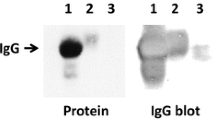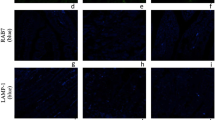Summary
The dome epithelium (DE), which covers gutassociated lymphoid tissues (GALT) and provides both a protective barrier over lymphoid follicles and a route for antigen uptake from the gut, develops in rabbit appendix (caecum) during the first week of neonatal life. To determine if secretory immunoglobulins from maternal milk interact with this developing tissue, their interrelationships in neonatal rabbit appendix were examined by use of immunocytochemical techniques. The glycoprotein, secretory component, was not produced by neonatal rabbits less than 15 days old, since neither the membranous nor the free, secreted forms of maternal secretory component were associated with villi or DE of neonates. Immunoglobulin A (IgA), but neither IgG nor IgM, were noted on DE by light microscopy, even though IgG was abundant in the villus lamina propria and vascular spaces. The epithelial IgA was distributed, in a patchy pattern, across the upper dome surface of some two-day-old, and all five-and ten-day old nursing animals, but IgA was not on DE of rabbits prevented from nursing. Immunoelectron microscopy of appendix from nursed rabbits revealed IgA directly over the apical surface of M cells, where it formed a continous, thick coating without binding to adjacent immature absorptive cells; it was also within apical vacuoles of M cell cytoplasm. The distribution of IgA on the DE of rabbit appendices indicated that in differentiating GALT, maternal IgA reacted preferentially with M cells or pre-M cells, leading to speculation concerning a role for IgA in the development of GALT and in establishment of mucosal immune responses in neonates.
In conducting the research described in this report, the investigators adhered to the standards set forth in the “Guide for the Care and Use of Laboratory Animals” (NIH Publication 85-23) as promulgated by the Committee on Care and Use of Laboratory Animals of the Institute of Laboratory Animal Resources, National Research Council, USA
Similar content being viewed by others
Abbreviations
- DE:
-
dome epithelium
- GALT:
-
gutassociated lymphoid tissues
- HRP:
-
horseradish peroxidase
- IgA:
-
immunoglobulin A
- SC:
-
secretory component
References
Allen WD, Porter P (1973) Localization by immunofluorescence of secretory component and IgA in the intestinal mucosa of the young pig. Immunology 24:365–374
Befus AD, Bienenstock J (1982) The mucosaassociated immune system of the rabbit. In: Hay JB (ed) Animal Models of Immunologic Processes. Academic Press, New York, pp 167–220
Bienenstock J, Befus AD (1980) Mucosal immunology. Immunology 41:249–270
Bookman DE, Cooper MD (1973) Pinocytosis by epithelium associated with lymphoid follicles in the bursa of Fabricius, appendix and Peyer's patches. An electron microscopic study. Am J Anat 136:455–478
Bockman DE, Boydston WR, Beezhold DH (1983) The role of epithelial cells in gutassociated immune reactivity. Ann NY Acad Sci 409:129–144
Brown WR, Isobe K, Nakane PK, Pacini B (1977) Studies on translocation of immunoglobulins across intestinal epithelium. IV. Evidence for binding of IgA and IgM to secretory component in intestinal epithelium. Gastroenterology 73:1333–1339
Buts J-P, Delacroix DL (1985) Ontogenic changes in secretory component expression by villous and crypt cells of rat small intestine. Immunology 54:181–187
Bye WA, Allan CH, Trier JS (1984) Structure, distribution, and origin of M cells in Peyer's patches of mouse ileum. Gastroenterology 86:789–801
Cebra JJ, Robbins JB (1966) Gamma A-immunoglobulin from rabbit colostrum. J Immunol 97:12–24
Crabbe PA, Nash DR, Bazin H, Eyssen H, Hermans JE (1970) Immunohistochemical observations on lymphoid tissues from conventional and germ-free mice. Lab Invest 22:48–53
Gilman-Sachs A, Dray SB (1972) Identification and genetic control of two rabbit IgM allotype specificities. Eur J Immunol 2:505–511
Hanson LA, Ahlstedt S, Andersson B, Carlsson B, Cole ME, Cruz JR, Dahlgren U, Ericsson TH, Jalil F, Kahn SR (1983) Mucosal immunity. Ann NY Acad Sci 409:1–21
Hemmings WA, Jones RE, Williams EW (1973) Transmission of IgA to the rabbit foetus and the suckling rat. Immunology 25:645–647
Kühn LC, Kraehenbuhl J-P (1983) Monoclonal antibodies recognizing the secreted and membrane domains of the IgA dimer receptor. Ann NY Acad Sci 409:751–759
Nagura H, Nakane PK, Brown WR (1978) Breast milk IgA binds to jejunal epithelium in suckling rats. J Immunol 120:1333–1339
Nagura H, Nakane PK, Brown WR (1979) Translocation of dimeric IgA through neoplastic colon cells in vitro. J Immunol 123:2359–2368
Nieuwenhuis P (1971) On the Origin and Fate of immunologically Competent Cells. Wolters-Noordhoff, Groningen, NL
Ogra PL, Dayton D (1979) Immunology of Breast Milk. Raven Press, New York
Ogra PL, Losonsky GA (1984) Defense factors in products of lactation. In: Ogra PL (ed) Neonatal Infections. Nutritional and Immunologial Interactions. Grune & Stratton, New York, pp 67–87
Owen RL (1977) Sequential uptake of horseradish peroxidase by lymphoid follicle epithelium of Peyer's patches in the normal unobstructed mouse intestine: an ultrastructural study. Gastroenterology 72:440–451
Owen RL, Jones AL (1974) Epithelial cell specialization within human Peyer's patches: an ultrastructural study of intestinal lymphoid follicles. Gastroenterology 66:189–203
Owen RL, Pierce NF, Apple RT, Cray WC Jr (1986) M eell transport of Vibrio cholerae from the intestinal lumen into Peyer's patches: A mechanism for antigen sampling and for microbial transepithelial migration. J Infect Dis 153:1108–1118
von Rosen L, Podjaski B, Bettman I, Otto HF (1981) Observations on the ultrastructure and function of the so-called “microfold” or “membranous” cells (M cells) by means of peroxidase as a tracer: An experimental study with special attention to the physiological parameters of resorption. Virchows Arch 390:289–312
Roy MJ (1987) Precocious development of lectin (Ulex europaens agglutinin I) receptors in dome epithelium of gutassociated lymphoid tissues. Cell Tissue Res (in press)
Roy MJ, Ruiz A, Varayanis M, Tseng J (1985) Molecular parameters of development in the follicle-associated epithelium (FAE) of gutassociated lymphoid tissues. J Leukocyte Biol 38:112 (abstract)
Roy MJ, Ruiz A, Varvayanis M (1987) A novel antigen is common to the dome epithelium of gut- and bronchus-associated lymphoid tissues. Cell Tissue Res (in press)
Sell S, Linthicum DS, Bass D, Bahu R, Wilson B, Nakane P (1977) Immunohistologic technics. In: Borck C et al. (eds) Cancer Biology. IV. Differentiation in Cell Biology. Stratton, New York, pp 272–305
Smith MW, Peacock MA (1980) “M” cell distribution in follicle-associated epithelium of mouse Peyer's patches. Am J Anat 159:167–175
Wolf JL, Rubin DH, Finberg R, Kauffman RS, Sharp AH, Trier JS, Fields BN (1981) Intestinal M cells: a pathway for entry of reovirus into the host. Science [Wash DC] 212:471–472
Author information
Authors and Affiliations
Additional information
The views of the authors expressed here do not purport to reflect the position of the Department of the Army or the Department of Defense
Rights and permissions
About this article
Cite this article
Roy, M.J., Varvayanis, M. Development of dome epithelium in gut-associated lymphoid tissues: Association of IgA with M cells. Cell Tissue Res. 248, 645–651 (1987). https://doi.org/10.1007/BF00216495
Accepted:
Issue Date:
DOI: https://doi.org/10.1007/BF00216495




